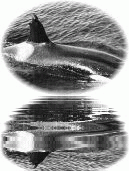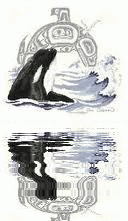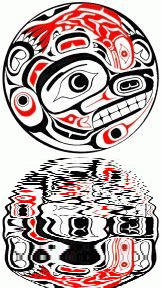
This site is dedicated with my highest degree of respect to honor my personal mentor, research adviser & cherished friend Dr. Michael Andrew Bigg as the world’s recognized leading authority of the Killer Whale “Orcinus orca” upon his death on the night of Thursday October 18, 1990. The vocalizations you are hearing, are transient Killer Whale populations seen in the waters of British Columbia and in his honor, are referred to as “Bigg’s Killer Whales” containing over 250 individuals.
Dr. Bigg received his Masters & Doctorate from the University of British Columbia based upon his groundbreaking research studies of Harbor Seals, while directing projects focusing on Northern Fur Seals, Northern Sea Lions & Pacific Sea Otters. His Doctorate was awarded in 1972 on the reproductive ecology of Harbor Seals. It is however, his unique pioneering work with Killer Whales that he will always be best remembered. His name will forever be synonymous with the creation of conducted field research techniques of Killer Whales, which remains the “benchmark” for all of today’s current cetacean research.
 It’s has been decades since Dr. Bigg photographed a group of Killer Whales in British Columbia’s Johnstone Strait. One of the whales had a distinctively chewed-up dorsal fin. “When we got back to the lab, we wondered if we could find and identify her again,” he recalled later. Starting with that chance photograph (on the right), he began work that has led to a remarkably detailed family tree for the Killer Whales of British Columbia and Washington waters over the years. Mike cataloged that first whale A1 with the nickname of “Stubbs” although he referred to her affectionately as “a 50 year-old Granny”, designating her as the first positively identified whale and leading to a genealogy for the pods of Killer Whales that reside in Pacific Northwest waters.
It’s has been decades since Dr. Bigg photographed a group of Killer Whales in British Columbia’s Johnstone Strait. One of the whales had a distinctively chewed-up dorsal fin. “When we got back to the lab, we wondered if we could find and identify her again,” he recalled later. Starting with that chance photograph (on the right), he began work that has led to a remarkably detailed family tree for the Killer Whales of British Columbia and Washington waters over the years. Mike cataloged that first whale A1 with the nickname of “Stubbs” although he referred to her affectionately as “a 50 year-old Granny”, designating her as the first positively identified whale and leading to a genealogy for the pods of Killer Whales that reside in Pacific Northwest waters.
In 1971, he was asked by the Canadian Government to count the number of Killer Whales present in the British Columbia region. This monumental task was too large for just one person,  so Mike asked the general public to send in their sightings of Killer Whales while conducting 3 individual censuses. This allowed him to come up with a more accurate estimate of the population size in British Columbia waters. He also discovered that each whale had unique “saddle” markings that allow it to be identified. Always glad to share his expertise and personal stories with anyone, Mike truly disliked the word “Orca” when discussing the Killer Whale and was very quick to correct you for using that word to describe the ocean’s top predator. We are indeed richer & extremely fortunate for having known Dr. Michael Andrew Bigg, as we continue to celebrate the strength of character that defined his life which continues to inspire & benefit the world’s scientific community’s ongoing oceanic field research.
so Mike asked the general public to send in their sightings of Killer Whales while conducting 3 individual censuses. This allowed him to come up with a more accurate estimate of the population size in British Columbia waters. He also discovered that each whale had unique “saddle” markings that allow it to be identified. Always glad to share his expertise and personal stories with anyone, Mike truly disliked the word “Orca” when discussing the Killer Whale and was very quick to correct you for using that word to describe the ocean’s top predator. We are indeed richer & extremely fortunate for having known Dr. Michael Andrew Bigg, as we continue to celebrate the strength of character that defined his life which continues to inspire & benefit the world’s scientific community’s ongoing oceanic field research.
In 1984, Mike was diagnosed with leukemia and was only 51 when he died at the Cowichan District Hospital in Duncan, BC. He is survived by his ex-wife Silke, a daughter Michelle, a son Colin who died in 2009, sisters Carol & Pamela  and his parents, Andy who passed away in 2003 and Irene who died in 1993. While ill, he had summarized his work in a pair of scientific papers for a volume on photo identification of Killer Whales that was to be published by the International Whaling Commission. Mike saw both papers the afternoon of the day he died. Mike’s ashes were scattered in the waters of Johnston Strait in the region formerly known as the “Robson Bight Ecological Reserve” which was later renamed the “Robson Bight/Michael Bigg Ecological Reserve”. This private region is now set aside by the Canadian government to protect this unique Killer Whale habitat.
and his parents, Andy who passed away in 2003 and Irene who died in 1993. While ill, he had summarized his work in a pair of scientific papers for a volume on photo identification of Killer Whales that was to be published by the International Whaling Commission. Mike saw both papers the afternoon of the day he died. Mike’s ashes were scattered in the waters of Johnston Strait in the region formerly known as the “Robson Bight Ecological Reserve” which was later renamed the “Robson Bight/Michael Bigg Ecological Reserve”. This private region is now set aside by the Canadian government to protect this unique Killer Whale habitat.
In 1994, I took the name “Robsonbight” as my internet moniker to honor his memory as he was like the older brother that I never had and who I truly miss even over the many years since his passing. Please share a reflective moment to remember the “Father of Killer Whale Research”, his extraordinary life & his ever-lasting legacy.